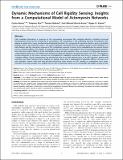Dynamic Mechanisms of Cell Rigidity Sensing: Insights from a Computational Model of Actomyosin Networks
Author(s)
Borau, Carlos; Kamm, Roger Dale
DownloadBorau-2012-Dynamic mechanisms o.pdf (1.137Mb)
PUBLISHER_CC
Publisher with Creative Commons License
Creative Commons Attribution
Terms of use
Metadata
Show full item recordAbstract
Cells modulate themselves in response to the surrounding environment like substrate elasticity, exhibiting structural reorganization driven by the contractility of cytoskeleton. The cytoskeleton is the scaffolding structure of eukaryotic cells, playing a central role in many mechanical and biological functions. It is composed of a network of actins, actin cross-linking proteins (ACPs), and molecular motors. The motors generate contractile forces by sliding couples of actin filaments in a polar fashion, and the contractile response of the cytoskeleton network is known to be modulated also by external stimuli, such as substrate stiffness. This implies an important role of actomyosin contractility in the cell mechano-sensing. However, how cells sense matrix stiffness via the contractility remains an open question. Here, we present a 3-D Brownian dynamics computational model of a cross-linked actin network including the dynamics of molecular motors and ACPs. The mechano-sensing properties of this active network are investigated by evaluating contraction and stress in response to different substrate stiffness. Results demonstrate two mechanisms that act to limit internal stress: (i) In stiff substrates, motors walk until they exert their maximum force, leading to a plateau stress that is independent of substrate stiffness, whereas (ii) in soft substrates, motors walk until they become blocked by other motors or ACPs, leading to submaximal stress levels. Therefore, this study provides new insights into the role of molecular motors in the contraction and rigidity sensing of cells.
Date issued
2012-11Department
Massachusetts Institute of Technology. Department of Biological Engineering; Massachusetts Institute of Technology. Department of Mechanical EngineeringJournal
PLoS ONE
Publisher
Public Library of Science
Citation
Borau, Carlos et al. “Dynamic Mechanisms of Cell Rigidity Sensing: Insights from a Computational Model of Actomyosin Networks.” Ed. Wilbur Lam. PLoS ONE 7.11 (2012): e49174.
Version: Final published version
ISSN
1932-6203